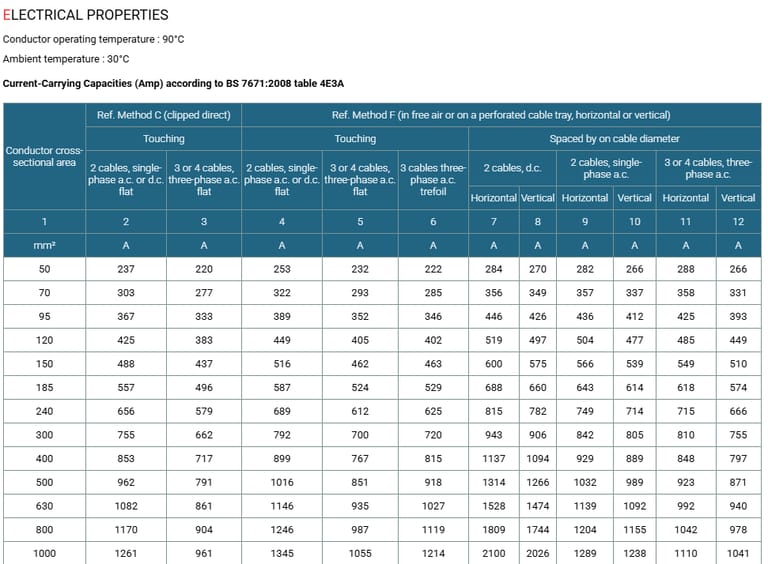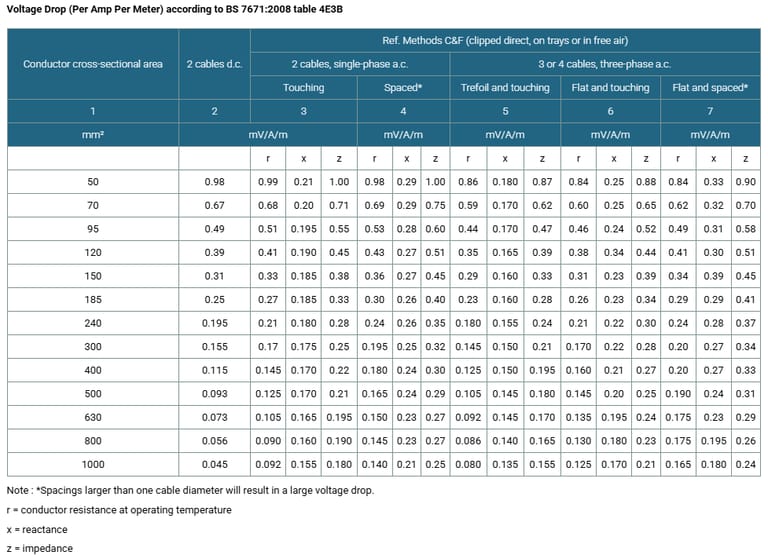Anhui Feichun Special Cable Co.,Ltd Li.wang@feichuncables.com

600/1000V Mica+XLPE Insulated, LSZH Sheathed, Armoured Power Cables to BS 6724 (Single Core)
APPLICATION
The cables are mainly used in power stations, mass transit underground passenger systems, airports, petrochemical plants, hotels, hospitals and high-rise buildings.
STANDARDS
Basic design adapted from BS 6724
FIRE PERFORMANCE
Circuit Integrity | IEC 60331-21; EN 6387; BS 8491 |
Flame Retardance (Single vertical wire or cable test) | IEC 60332-1-2; EN 60332-1-2 |
Reduced fire Propagation (Vertically-mounted bundled wires & cables test) | IEC 60332-3-24; EN 60332-3-24 |
Halogen Free | IEC 60754-1; EN 50267-2-1 |
No Corrosive Gas Emission | IEC 60754-2; EN 50267-2-2 |
Minimum Smoke Emission | IEC 61034-2; EN 61034-2 |
VOLTAGE RATING
600/1000V
CABLE CONSTRUCTION
Conductor : Annealed copper wire, stranded according to BS EN 60228 class 2.
Fire Barrier : Mica glass tape.
Insulation : XLPE type GP 8 according to BS 7655-1.3. HEPR type GP 6 according to BS 7655-1.2 or crosslinked polyolefin material type EI 5 according to BS EN 50363-5 can be offered as option.
Bedding : Extruded layer of polymeric material.
Armouring : Aluminium wire.
Outer Sheath : Extruded layer of polymeric material LTS 1 according to BS 7655-6.1.
Outer Sheath Option : UV resistance, hydrocarbon resistance, oil resistance, anti-rodent and anti-termite properties can be offered as option.
COLOUR CODE
Insulation Colour : Brown or blue; other colours can be offered upon request.
Sheath Colour : Black; other colours can be offered upon request.
PHYSICAL AND THERMAL PROPERTIES
Maximum temperature range during operation : 90°C
Maximum short circuit temperature (5 Seconds) : 250°C
Minimum bending radius : 6 × Overall Diameter
CONSTRUCTION PARAMETERS
Conductor | FFX300 1mRZ1MAZ1-R | ||||||
|---|---|---|---|---|---|---|---|
No. of Cores × Cross-sectional Area | Conductor Class | Nominal Insulation Thickness | Nominal Bedding Thickness | Nominal AL Wire Armour Diameter | Nominal Sheath Thickness | Approx. Overall Diameter | Approx. Weight |
no.×mm² |
| mm | mm |
| mm | mm | kg/km |
2 | 1.0 | 0.8 | 0.9 | 1.5 | 18.5 | 696 | |
2 | 1.1 | 0.8 | 1.25 | 1.5 | 21.2 | 949 | |
2 | 1.1 | 0.8 | 1.25 | 1.6 | 23.3 | 1253 | |
2 | 1.2 | 0.8 | 1.25 | 1.6 | 25.2 | 1533 | |
2 | 1.4 | 1.0 | 1.6 | 1.7 | 28.4 | 1863 | |
2 | 1.6 | 1.0 | 1.6 | 1.8 | 31.0 | 2304 | |
2 | 1.7 | 1.0 | 1.6 | 1.8 | 33.8 | 2938 | |
2 | 1.8 | 1.0 | 1.6 | 1.9 | 36.6 | 3626 | |
2 | 2.0 | 1.2 | 2.0 | 2.0 | 41.5 | 4668 | |
2 | 2.2 | 1.2 | 2.0 | 2.1 | 45.2 | 5795 | |
2 | 2.4 | 1.2 | 2.0 | 2.2 | 49.8 | 7357 | |
2 | 2.6 | 1.4 | 2.5 | 2.4 | 56.4 | 9380 | |
2 | 2.8 | 1.4 | 2.5 | 2.5 | 61.6 | 11660 | |


Introduction
In the realm of electrical engineering, the selection of appropriate power cables is paramount to ensuring safety, reliability, and efficiency in power distribution systems. This is particularly true in South Africa, where diverse environments—from arid mining sites in the Northern Cape to bustling urban centres in Gauteng—demand robust solutions that can withstand extreme conditions. Among the most advanced options available are the 600/1000V Mica+XLPE insulated, LSZH sheathed, armoured power cables, designed in accordance with BS 6724 standards. These single-core cables represent a pinnacle of fire-resistant technology, combining mica glass tape for circuit integrity with cross-linked polyethylene (XLPE) insulation and low smoke zero halogen (LSZH) sheathing to minimise hazards during fire incidents.
South Africa's infrastructure landscape, characterised by rapid urbanisation, expanding renewable energy projects, and stringent safety regulations, has seen increasing adoption of these cables. With a voltage rating of 600/1000V, they are engineered for medium-voltage applications where fire performance is critical.
Applications
These cables are versatile, primarily used in power stations, mass transit systems, airports, petrochemical plants, hotels, hospitals, and high-rise buildings. Their fire-resistant nature makes them indispensable where circuit integrity saves lives, such as in emergency lighting and alarm systems.
In South Africa, applications abound. In mining operations, like those in the Witwatersrand basin, the armoured design protects against mechanical damage from heavy machinery. Renewable energy projects, such as wind farms in the Eastern Cape, benefit from UV-resistant options for outdoor exposure. Urban infrastructure, including Johannesburg's high-rises, relies on LSZH properties to comply with fire codes under the National Building Regulations (SANS 10400).
Petrochemical facilities in Secunda utilise hydrocarbon-resistant variants, while hospitals in Durban employ them for uninterruptible power supplies. The cables' halogen-free emission profile is vital in confined spaces like the Gautrain tunnels, preventing toxic fumes during potential fires.
The 600/1000V Mica+XLPE insulated, LSZH sheathed, armoured power cables to BS 6724 embody a synergy of innovation and safety, tailored for demanding environments. Their superior fire performance, robust construction, and electrical efficiency make them indispensable in South Africa's evolving infrastructure. As the nation invests in sustainable development—from Gautrain expansions to renewable hubs—these cables will continue to play a pivotal role in safeguarding lives and assets. Engineers and policymakers should prioritise such technologies to build a resilient future, where power reliability meets uncompromising safety standards.

Email Address: Li.wang@feichuncables.com
© 2025. All rights reserved.


One-click to Quickly Contact
Products
Offshore & Marine Cable
XLPE Cable
Contact
Company
Location:
Building A Private Science and Technology Park, Hefei Economic and Technological Development Zone, Anhui Province, China
